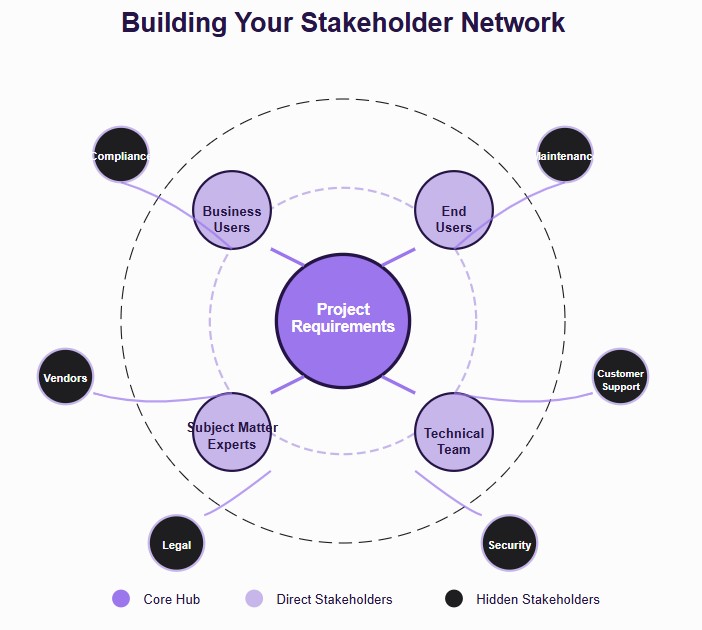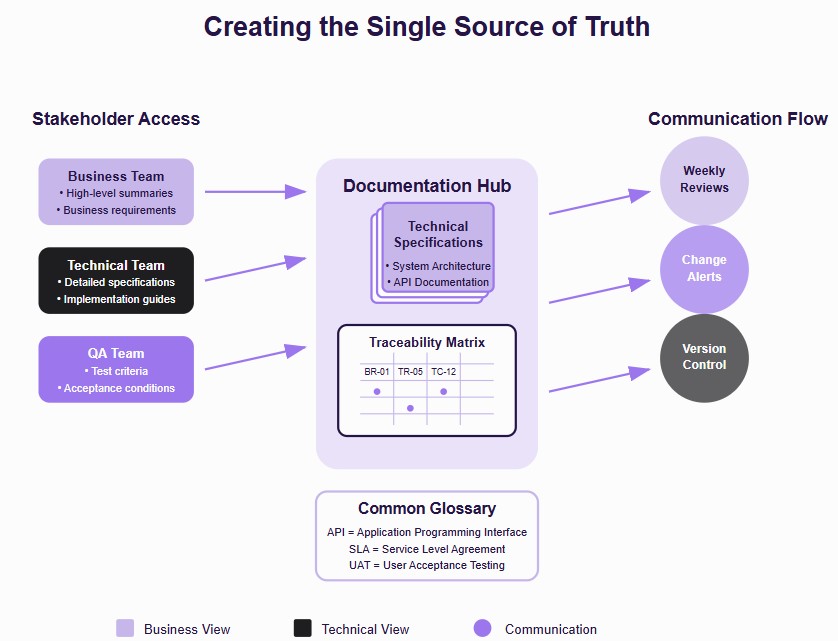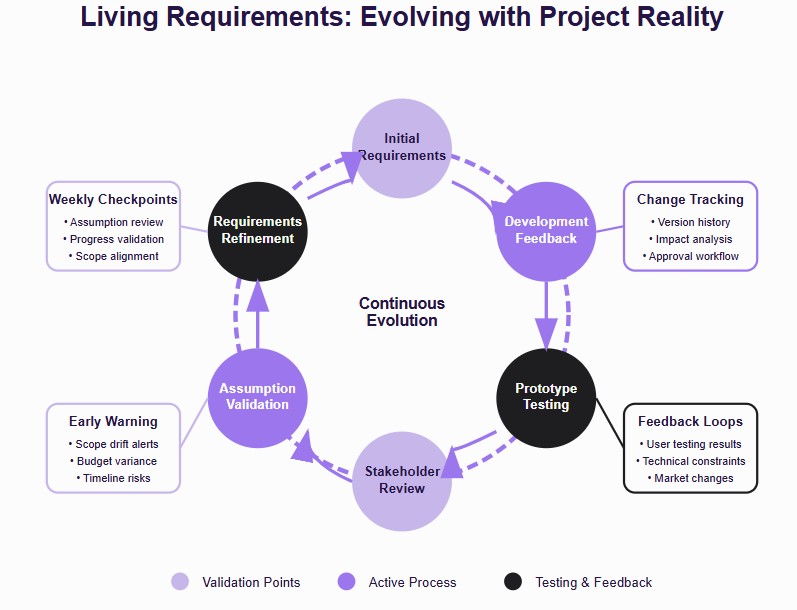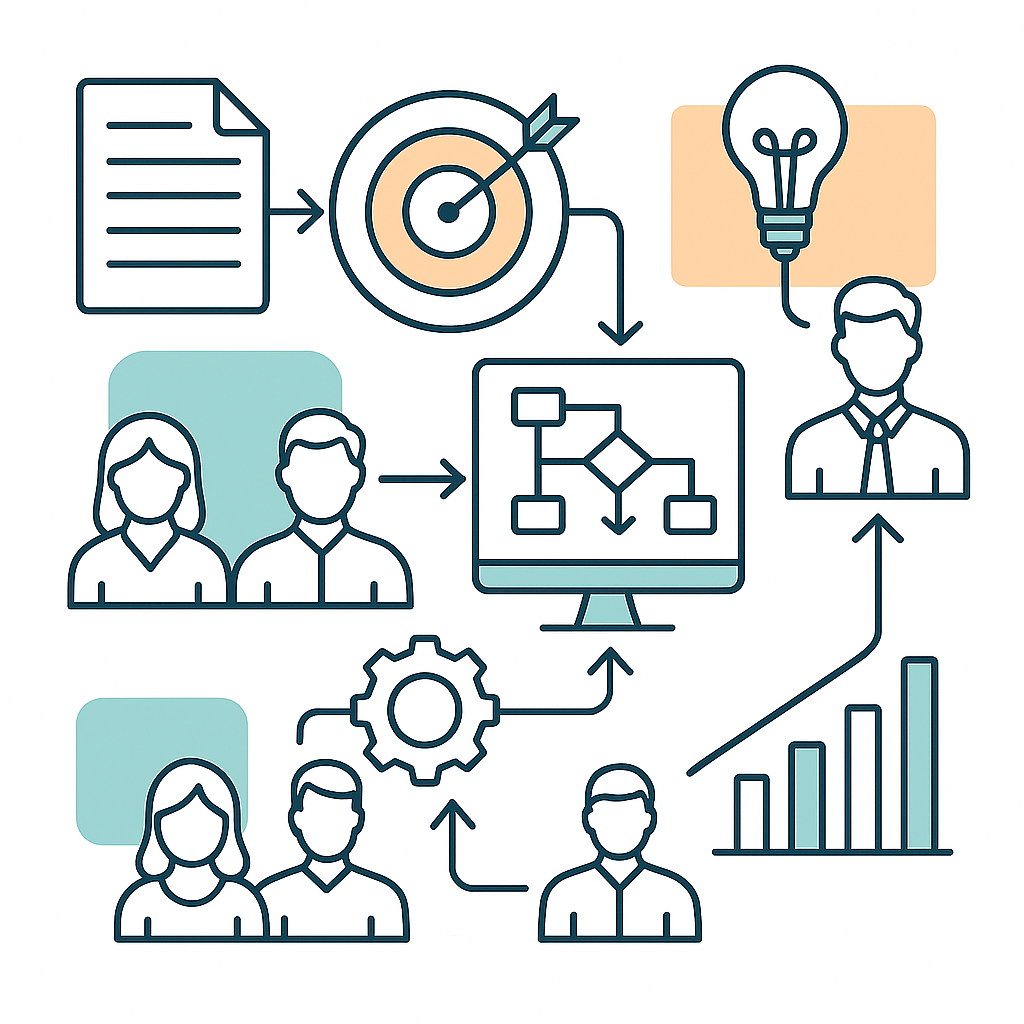A misplaced line of code once sent a $1.2 billion NASA satellite tumbling into the void because the technical team misunderstood the business requirements. Misalignment like that can quietly destroy projects in any industry.
Knowing how to translate business needs into technical requirements is the key to avoiding costly mistakes and ensuring every feature built moves the business forward.
In this article, we will:
- Translate business goals into developer-ready tasks in 6 clear steps
- Watch how real-world examples turn strategy into specs
- Use the right tools to make requirement translation faster and smarter
Turn business goals into developer-ready requirements: A 6-step framework that works
Bridging the gap between what the business wants and what the tech team delivers can make or break your project. This 6-step framework provides a repeatable method for translating business needs into clear, actionable technical requirements, eliminating the usual confusion.
Step 1: Stakeholder identification and engagement
Getting the right people involved from day one determines whether you'll discover critical requirements early or face costly surprises later. Missing key stakeholders means missing essential perspectives that could derail your project. Your success depends on casting a wide net initially, then strategically managing each relationship throughout the process.
Here's how to systematically identify and engage all relevant stakeholders:
- Map all relevant stakeholders: business users, end users, technical teams, and subject matter experts (SMEs)
- Conduct stakeholder analysis to gauge influence levels and gather initial expectations
- Build a stakeholder matrix that distinguishes internal (e.g., product teams) from external (e.g., vendors, customers)
- Identify hidden stakeholders like compliance teams, maintenance staff, and customer support who often hold crucial requirements
Pro Tip: Use the "ripple effect" technique - ask each stakeholder who else might be impacted by changes to their workflow. This often reveals overlooked stakeholders who become vocal opponents if excluded.

Step 2: Business requirements elicitation
Effective elicitation goes beyond asking "what do you want" to understanding the underlying business drivers and constraints. The best requirements emerge when you help stakeholders articulate not just their immediate requests, but the business outcomes they're trying to achieve. This step transforms vague wishes into concrete, measurable business requirements.
To extract meaningful requirements that drive real business value:
- Conduct structured interviews using open-ended questions to uncover real business needs versus surface-level requests
- Deploy surveys and questionnaires for gathering standardized input from large stakeholder groups
- Facilitate collaborative workshops where cross-functional teams can identify requirements together
- Perform direct observation of current workflows to spot inefficiencies and unspoken pain points
- Document business goals and success criteria, ideally using a project information sheet template, that will guide all technical decisions.
Pro Tip: Always ask "What happens if we don't address this?" for each requirement. This reveals the true business impact and helps prioritize requirements based on actual consequences.
Step 3: Requirements analysis and validation
Raw requirements are often contradictory, unrealistic, or incomplete—this step transforms them into a coherent foundation for development. Proper analysis prevents the common scenario where teams build exactly what was requested but miss what was actually needed. Validation ensures everyone agrees on priorities before expensive development work begins.
Follow this systematic approach to refine and validate your requirements:
- Prioritize requirements using frameworks like MoSCoW (Must have, Should have, Could have, Won't have)
- Validate requirements with stakeholders through structured review sessions and formal sign-offs
- Identify constraints and dependencies, including technical limitations, regulatory requirements, and integration needs
- Document assumptions that could invalidate requirements if proven false later
- Resolve conflicts between competing stakeholder needs through facilitated discussions
Pro Tip: Create a "requirements conflict register" to track opposing stakeholder needs. Instead of choosing sides, dig deeper to find the underlying business problem that creative technical solutions might address for all parties.
Step 4: Technical translation process
This is where business language becomes developer language without losing meaning or intent. The goal is to create technical specifications that are detailed enough for implementation while remaining traceable to the original business needs. Successful translation requires deep collaboration between business analysts and technical teams to ensure solutions are both feasible and valuable.
Execute these critical translation activities to bridge the business-technical gap:
- Convert business requirements into detailed functional and non-functional technical specifications
- Define system functionality, including user interactions, data processing rules, and business logic implementation
- Specify technology stack requirements, considering existing infrastructure, security needs, and scalability demands
- Map component interactions showing how different system parts will communicate and share data
- Collaborate with development teams to validate technical feasibility and identify potential implementation challenges
Pro Tip: Use "solution-neutral" language in technical specifications. Instead of specifying "dropdown menu," write "allow users to select from predefined options." This gives developers flexibility while ensuring business needs are met.

Step 5: Documentation and communication
Clear documentation serves as the project's single source of truth, preventing misunderstandings that lead to rework and scope creep. Effective communication bridges the vocabulary gap between business and technical teams. This step ensures your translation work becomes a reliable reference that keeps everyone aligned throughout the development lifecycle.
Implement these documentation and communication strategies to maintain project alignment:
- Create comprehensive technical specification documents including functional requirements, system architecture, and integration details
- Ensure clear traceability linking every technical specification back to its originating business requirement
- Establish common language through glossaries that define terms consistently across business and technical teams
- Build requirements traceability matrices showing relationships between business needs, technical specifications, and test cases
Pro Tip: Apply the "grandmother test" - if someone unfamiliar with your project can read your business requirements and understand what the system should accomplish, your documentation is clear enough for successful implementation.

Step 6: Continuous validation and iteration
Requirements aren't static documents - they evolve as teams learn more about the problem and solution space. Regular validation, paired with a well-documented project onboarding template, prevents the drift between what was specified and what's actually needed. This step builds feedback loops that catch misalignments early when they're still inexpensive to correct.
Establish these ongoing validation practices to keep requirements aligned with reality:
- Implement regular review cycles throughout the project lifecycle to ensure requirements remain accurate and relevant
- Establish feedback loops between business stakeholders and technical teams for ongoing clarification and validation
- Conduct requirements refinement as new information emerges or project constraints change
- Perform iterative validation through prototypes, mockups, and incremental deliveries
- Monitor assumption validity by regularly checking whether documented assumptions still hold true
Pro Tip: Schedule "assumption validation checkpoints" every few weeks to explicitly review your documented assumptions with stakeholders. You'll be amazed how many assumptions become invalid as projects progress, and catching these early prevents major course corrections later.

This framework doesn’t just help you write better technical requirements; it helps your entire team deliver the right solution, faster.
See it in action: Real examples that translate business goals into technical specs
Knowing the theory is one thing, but seeing how business needs turn into real, developer-ready requirements makes all the difference. Below, we showcased how high-level business goals are dissected, translated, and implemented as technical actions.
These examples are especially helpful for product managers, business analysts, and non-technical stakeholders who want to understand how strategic intent becomes software reality.

eCommerce example: Reduce cart abandonment
Business Ask:
“We want to reduce the number of customers who add products to their cart but never complete checkout.”
At first glance, this may sound like a marketing or customer behavior issue. But it can and should be supported through precise technical solutions.
Translated Technical Requirements:
- Detect inactivity on the checkout page for over 10 minutes
- Automatically trigger an abandoned cart email 30 minutes after inactivity with a dynamic cart summary
- Add a progress bar on the checkout page to increase completion rate
- Enable persistent cart tracking across sessions and devices via user ID or cookie
Pro Tip: Always ask “What specific user action or inaction defines the ‘abandonment’?” That clarity helps developers build exact triggers and conditions.
SaaS example: Speed up user onboarding
Business Ask:
“Users are dropping off during onboarding. We need a faster and smoother experience.”
This is a great example of a vague business goal that needs precise technical translation to drive development.
Translated Technical Requirements:
- Replace the current 6-step onboarding with a 3-step signup process
- Include autosave functionality so users don’t lose progress when they exit
- Implement real-time identity validation (via phone number or email OTP)
- Add tooltips and progress indicators to guide users through setup
Pro Tip: Break down onboarding analytics to see where users drop off. Then translate that insight into UX-focused technical solutions.
These examples demonstrate that successful translation isn't about converting wishes into features; it's about understanding business problems deeply enough to design technical solutions that deliver measurable business value.
Power up your process: Essential tools that transform requirements translation
Translating business needs into precise technical requirements isn’t just a skill; it’s a process that becomes faster, clearer, and more scalable when you use the right tools.
Whether you're a business analyst, product owner, or technical lead, these tools help you capture, structure, visualize, and track requirements throughout the project lifecycle.
Here’s a breakdown of essential tools across every stage of the translation process:
Requirements management tools
These platforms help you gather, organize, and maintain requirements in one place, making it easier to manage complexity and ensure team alignment.
- Dart - Built for modern teams, Dart blends AI-powered requirement analysis, stakeholder insights, and decision tracking into one smart workspace. It’s especially useful for projects involving cross-functional collaboration and ongoing change.
- Confluence - A popular tool from Atlassian for creating and organizing requirement documents in a collaborative wiki-style format.
- Azure DevOps - Ideal for enterprise-scale projects, offering integrated requirement tracking, versioning, and connection to backlog items or user stories.
Pro Tip: Choose tools that support version control and traceability to avoid rework when requirements evolve.
Diagramming and visualization tools
Visualizing workflows and technical logic helps bridge the communication gap between stakeholders and developers.
- Lucidchart - Great for process diagrams, architecture flows, and system interactions.
- Whimsical - Lightweight and perfect for user story mapping, wireframes, and journey flows.
- Miro - Ideal for remote workshops, brainstorming, and stakeholder collaboration through real-time whiteboarding.
Why it matters: A picture often explains more than a paragraph, especially when translating non-technical goals into actionable architecture.
Collaboration & documentation tools
These platforms ensure everyone stays on the same page during the requirements lifecycle, literally and figuratively.
- Slack - Best for real-time communication, quick clarifications, and linking to requirement items.
- Notion - A flexible workspace to document requirements, create templates, and link related data.
- Google Docs - Universally accessible and simple to use for drafting and sharing requirement drafts.
Bonus Tip: Combine Google Docs for initial drafts with Dart or Confluence for formalized version-controlled documentation.
Traceability tools
Traceability ensures every technical feature maps back to its original business intent. These tools help you track dependencies and verify coverage.
- Jama Connect - Widely used in industries with high regulatory or engineering complexity. Great for end-to-end requirement traceability and risk analysis.
- ReqView - A lightweight yet powerful tool for small to mid-sized teams focused on structured specs and audit trails.
Tools don’t replace critical thinking, but when chosen right, they eliminate friction, reduce miscommunication, and make your translation process bulletproof.
Close the gap between business goals and tech execution
Misalignment derails even the best-planned projects. When teams truly understand what needs to be built and why, every feature becomes a driver of value, especially when backed by a measurable value realization template, not just a ticket in the backlog.
Use clear communication, structured processes, and the right tools to ensure business and tech stay in lockstep. That’s how you move from scattered execution to meaningful, measurable outcomes.



_light%201.png)





